HOW TO VISIT THE HOH RAIN FOREST FROM SEATTLE (AND WHY WE’RE MAKING IT EASY)

Walking beneath a moss-covered branch in the Hoh Rain Forest – Olympic National Park
In my years as a professional tour guide, I’ve noticed one recurring question which I had no good answer for:
“How can I visit Olympic National Park without a car?”
My usual answer included an explanation of how even though the park is relatively close to Seattle, public transit on the Olympic Peninsula is nearly non-existent. I would also tell people about the single-day tours available, but adding the huge caveat that the time constraints of a single day render it impossible to see more than a tiny fraction of the park (the Northeast corner closest to Seattle). This means you would miss out on the park’s most unique features (the Hoh Rain Forest and Pacific beaches) which make it the crown jewel of the entire National Park system (in my humble opinion). Therefore, I always suggested renting a car and spending at least a couple of days exploring the park.
Renting a car, of course, wasn’t an option for everyone (especially international travelers), and the rental car shortage of the last couple of years made it difficult and cost-prohibitive for just about everyone. Believe it or not, I would sometimes feel so bad about the lack of options that I would be tempted to offer to drive and show them around the park myself. Clearly, there was a need that wasn’t being met, which is why we’ve decided to introduce the first (and only) 2-day Olympic National Park tour from Seattle.
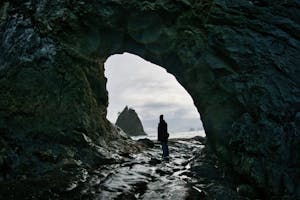
Hole in the Wall – Rialto Beach – Olympic National Park
If you’ve landed on this article, it’s probably safe to assume you already know a bit about Olympic National Park and what makes it so special, but just in case, let’s highlight some of the most spectacular areas of this massive (nearly a million acres) park, beginning with those on the Western side that a single-day tour just can’t reach:
Visiting The Hoh Rain Forest

The exposed root system of a felled Sitka spruce on the Spruce Nature Trail – Hoh Rain Forest – Olympic National Park
If there’s one thing people associate with Olympic National Park, it’s the Hoh Rain Forest, and with good reason. It’s the largest temperate rainforest in the contiguous U.S., and also the wettest, with an average annual rainfall of 140 inches. This climate creates the perfect conditions for towering trees draped in vibrant green mosses and lichens (over 130 species of these Epiphytes – “plants that grow upon plants”), a magical environment that words truly can’t capture. The Hoh Rain Forest has been awarded the distinction of being a UNESCO World Heritage Site and a Biosphere Reserve, and its ecosystem is now the most carefully preserved rain forest in the northern hemisphere. Due to this exceptional climate, the best time to visit the Hoh Rain Forest is between Spring and Fall.
One reason a visit here can’t be adequately described, only experienced, is because of the way this forest envelops all of your senses. As visually striking as the sea of infinite green might be, the experience is augmented by the smell of earthy Sitka spruce, sweet western red cedar, and subtle citrus from the western hemlock. Most noteworthy, however, is the silence created by all of that moss, fog, and isolation which makes it one of the quietest places on earth. The contrast with all the noise of our modern world is striking, and this unique experience would benefit just about anyone, which is why I’m so eager to bring people into this amazing space.
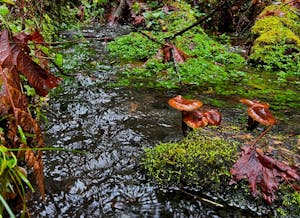
Mushrooms in Taft Creek – Hoh Rain Forest – Olympic National Park
Pacific Beaches

Kalaloch Beach – Olympic National Park
Forget whatever visions of a sandy, tropical paradise the word “beach” might evoke for you and imagine something far more rugged, dramatic, and thrilling. The first thing you’ll notice is the forest of enormous driftwood logs worn by the surf into striking sculptures. This is, in part, due to the fact that you may need to scale some of this driftwood to reach the beach. Once you see (and hear) the crashing waves of the Pacific ocean, you’ll be able to sense the extreme forces that sculpted this driftwood, along with the sea stacks and other rock formations you’ll also get a chance to explore.
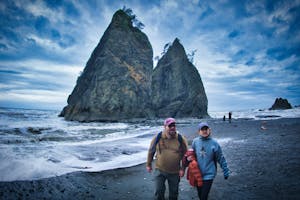
Sea stacks at Rialto Beach – Olympic National Park
On tours that allow us to reach the Pacific coast at low tide, you’ll get a chance to discover the microcosm of marine life in the tide pools where you can find sea stars, anemones, and urchins among the many life forms calling these rock formations home. You’re also likely to see bald eagles soaring above as you experience a beach that’s probably unlike any you’ve seen before.

Sea Anemone in tidepool – Rialto Beach – Olympic National Park
Hurricane Ridge
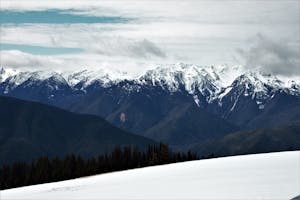
Hurricane Ridge – Olympic National Park
The highest elevation we can drive to in the park (5,242 feet), the winds here (which can reach up to 75 miles per hour) are the reason for the name Hurricane Ridge. You’ll understand why the earliest explorers to this region dubbed this mountain range the Olympics, the sight of them evoking visions of a home for Greek gods, as you learn about the tectonic forces just off the coast, wind, and 30-35 feet of annual snowfall that shape this rugged terrain.

Olympic Marmot – Hurricane Ridge – Olympic National Park
Hurricane Ridge is also where you’re most likely to see (or hear the unique whistle) of the Olympic Marmot, a species found nowhere other than the Olympic Peninsula.

Roosevelt Elk in the Hoh River – Olympic National Park
You’re also likely to see some of the 5,000 Roosevelt Elk (the largest of the four surviving subspecies of elk) who make their homes in this park, the largest known population on earth. Protecting the elk was the primary motivation for creating this national park, whose original proposed name was “Elk National Park.”
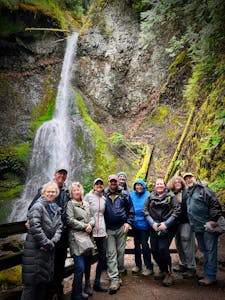
Marymere Falls – Olympic National Park
Some other tour highlights include mesmerizing waterfalls (Marymere and/or Madison Falls), pristine Lake Crescent and the fascinating Elwha River, site of the largest dam removal project in US history which is also one of the greatest success stories of ecological restoration.
These three distinct ecosystems lead many to describe this UNESCO World Heritage Site and Biosphere Reserve as three parks in one, with its lush temperate rain forests, over 70 miles of wild coastline, and towering mountain peaks. Even our 2-day tour can only scratch the surface of this park’s spectacular 922,650 acres, but hopefully, you can recognize what a shame it would be to only visit one of these three distinct biospheres on a single-day tour. This wraps up our guide on How to Visit the Hoh Rainforest from Seattle (and why we’re making it easy) and the unique locations you should visit. Hope you’re able to join us for one of these incredible adventures!

Tree of Life – Kalaloch Beach -Olympic National Park
